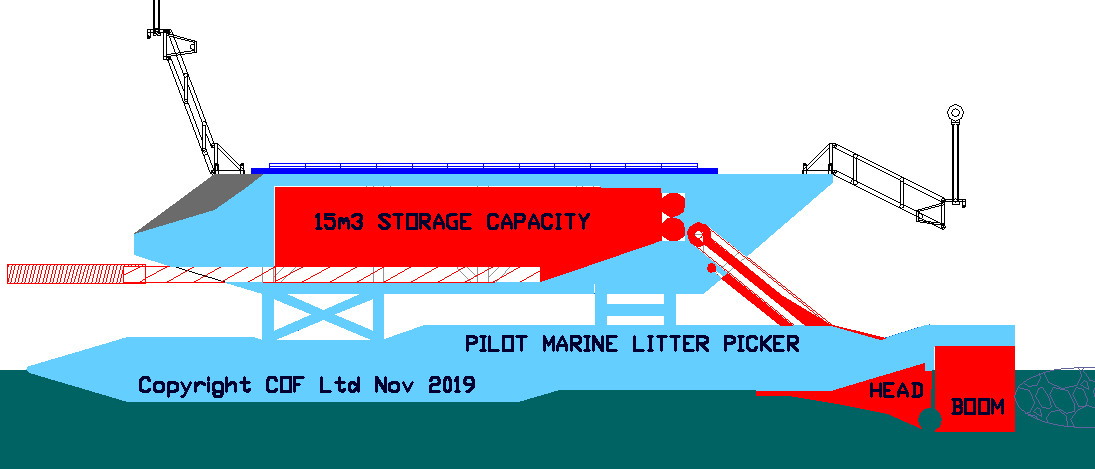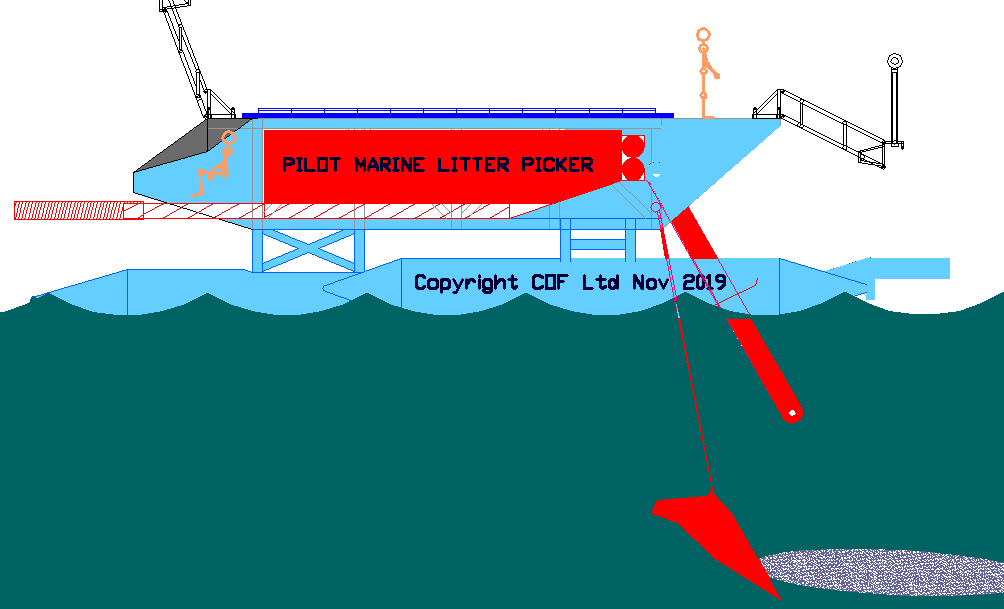|
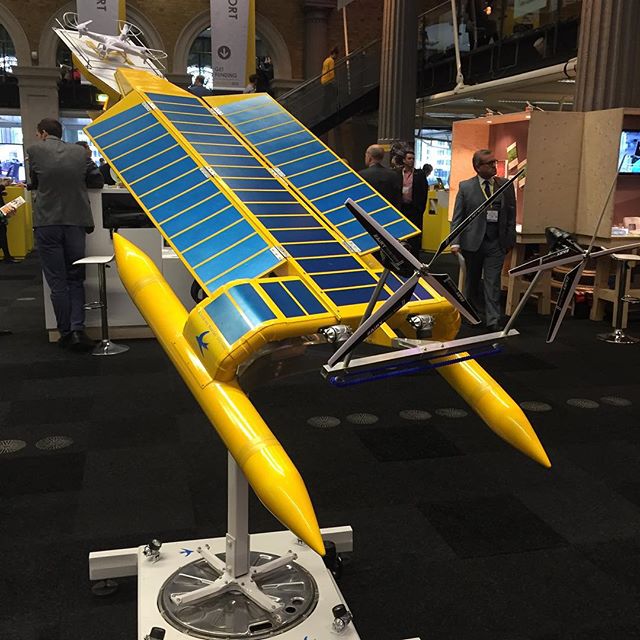
FUTURE
OF RIVER CLEANING -
In 2016-17 Bluebird Marine suggested that a modification of the SeaVax above could cleanse river
water without adding to
climate
change. This clean-tech could improve social conditions in many
locations around the world and help to prevent effluent discharges into
our oceans. Since then Bluebird Marine ceased trading, handing over the
development baton to the Cleaner
Ocean Foundation. It has taken a while for the dust to settle, but
plans are afoot to build a 12 meter coastal test rig that doubles as a
river sampler from 2020, dependent on the success of a hydraulically
operated mast being tested on a Ford
Transit in 2019. See draft diagrams below.
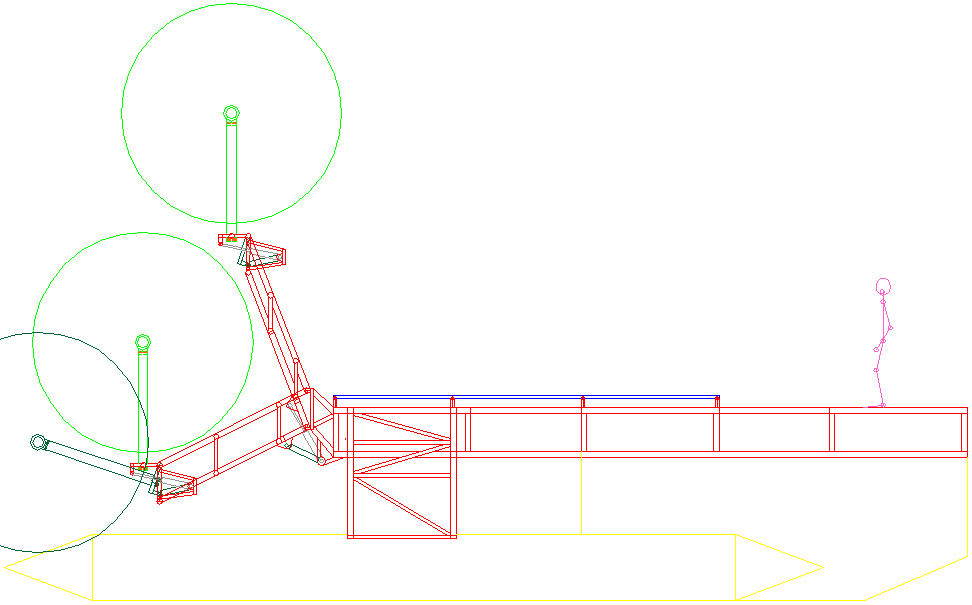
DRAFT
RIVER DESIGN - This
drawing is of a draft design for a river and coastal development rig that
is solar and wind powered; based on the SeaVax
concept. Unlike SeaVax, this low budget experimental boat will be built of
steel
to keep the up front costs down, though for long-term use the designers
would favour aluminium
alloys. Unlike a dustcart that collects household waste, there is no
immediately obvious health hazard from not cleaning rivers or patrolling
coastlines, rather it is out of sight, toxic, cumulative and just as
deadly, but hidden from view. Though some cities do patrol their rivers.
Those that do so are working towards not dumping waste at sea as per MARPOL
law, though marine law may not apply to river dumping - something that
needs to be looked at. Where does one law end and another begin? Copyright
© drawing 28 March 2019. All rights reserved, Cleaner Ocean Foundation
Ltd.
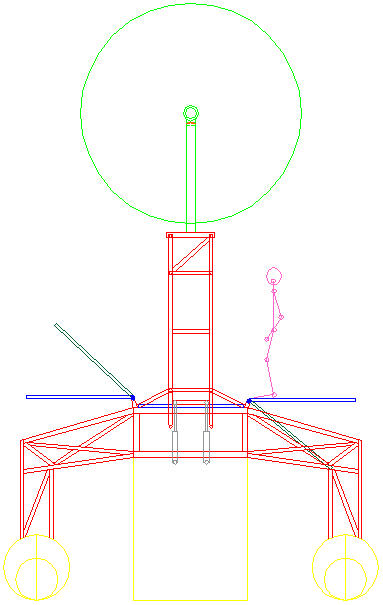
COASTAL/RIVER
DESIGNS - These drawings
show a single 1.5kW wind turbine mast that can be raised and folded, an
experiment that is planned for 2020 - funding dependent. The solar panel
arrays can also move to track the sun. We would like to run a series of
tests to determine what format works best in a range of conditions.
Ultimately, the vast oceans are the final experiment. It will help us to
refine the formula for an international cleaning plan to have data from
running coastal trials. Copyright © diagrams 28 March 2019. All rights
reserved, Cleaner Ocean Foundation Ltd.
SEAVAX
'PILOT' LITTER PICKER -
This is a 16 meter version of SeaVax.
In these diagrams we are looking through the superstructure from the side
of the vessel. [Left] We can see a boom ahead of the cleaning head on the
right, guiding marine litter and plastic into the filtration head in
surface skim mode, where it is lifted up into the large storage chamber by
a conveyor, then carried to a harbour for offloading and treatment.
[Right] In this diagram we see the selective filter cleaning head lowered
to a depth of 8 meters to deal with deeper historic plastics on riverbeds
and other coastal areas.
The
vessel is designed to navigate itself to a designated location, with input
from human operators, where a dockside container system for convenient
recycling allows speedy turnarounds. These cleaning machines may be moored
in rivers to collect plastic, a strategy that was proposed in 2016 - hence
the A-Z
of dirty rivers. Copyright © diagrams 21 & 25 November 2019. All
rights reserved, Cleaner Ocean Foundation Ltd.
Several companies offer equipment to fish garbage out of rivers, lakes and
harbors. Many say they could build larger dustcarts for seas and oceans,
if there was a demand for them. Those seen here may not be ideal for
collection on a large scale, but it is food for thought.
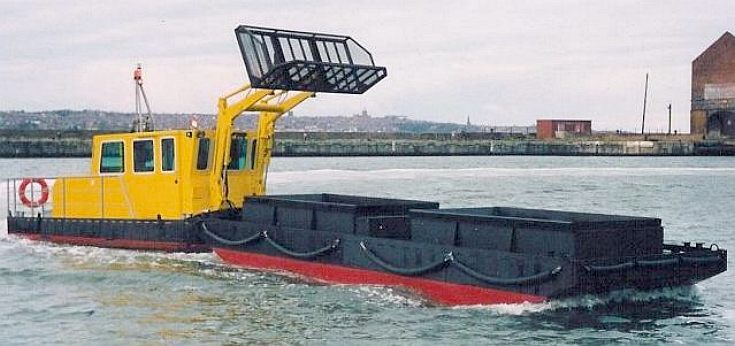
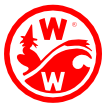
LIVERPOOL
WATER WITCH MARINE & ENGINEERING
The British company Water Witch offers two boats that are especially designed to clean up marine debris. The Buddy Catamaran
is a litter retrieval and waterway maintenance boat for marinas, harbors and inland waterways.
The Buddy is built from aluminium and designed for ease of operation and low cost of ownership, this road-transportable vessel features a removable basket, which can be lifted and tipped directly into a skip or shore side receptacle for disposal. The boat can filter a water surface of 92 x 92 metres per hour. The filter system can be adjusted to collect different sizes of flotsam. 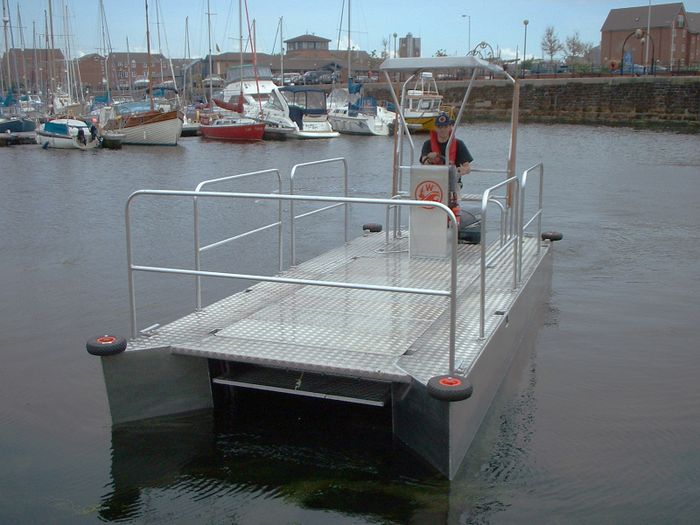
| Model |
6m Buddy |
7m Buddy |
8m Buddy |
| . |
. |
. |
. |
|
Length
(Hull)
|
5.83m
(19')
|
7m
(23')
|
8m
(26' 3")
|
|
Breadth
|
2.30m
(7' 7")
|
2.50m
(8' 2")
|
2.50m
(8' 2")
|
|
Depth
|
0.70m
(2' 4")
|
0.70m
(2' 4")
|
0.70m
(2' 4")
|
|
Operating
Draft (unladen)
|
0.20m
(8")
|
0.20m
(8")
|
0.20m
(8")
|
|
Displacement
(unladen) inc. Basket
|
700kg
(1543 lbs)
|
1,200kg
inc. cab (2645 lbs)
|
1,200kg
(2645 lbs
|
|
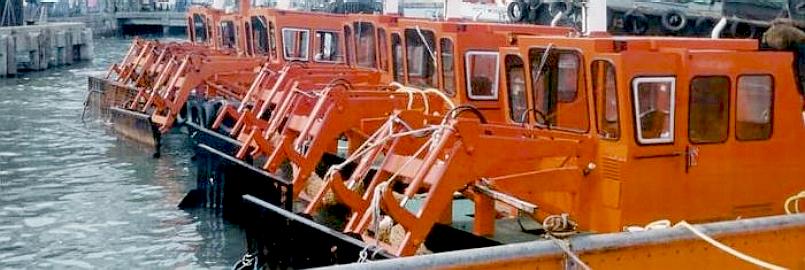
Some
river authorities take the duty to keep their patch clean seriously. This
is an excellent example of a harbor that employs a whole fleet of dredgers
- the dustcarts of the ocean.
BUDDY CATAMARAN SPECIFICATIONS
These features are standard across the Buddy range
* All-welded certified 4mm 5083 marine grade aluminium for strength, high durability, low
maintenance and a long working life
* Built-in lifting points
* Drop-in handrails with strengthened locking feet
* 5-bar aluminium tread plate decks
* Wheel Fenders
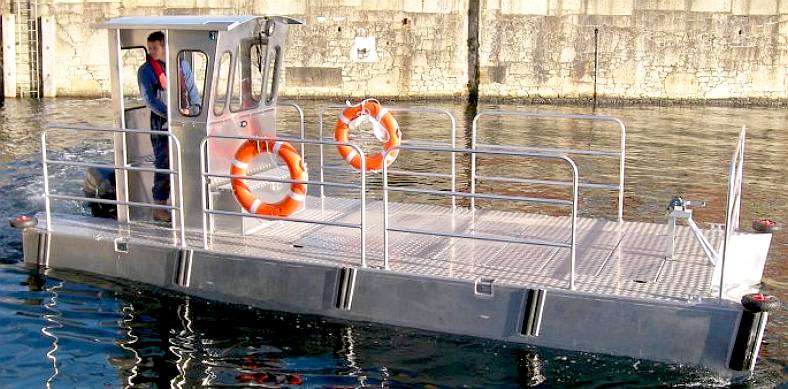
Interchangeable Pod System
The Buddy is extremely adaptable for a huge range of applications ranging from fast-response to pollution control needs, to diving and maintenance support. This vessel really earns her keep!
The design incorporates a variety of 'pods' that sit between the twin hulls enabling many tasks to be undertaken. The pod system allows heavy items to be loaded directly onto the quayside and lifted onto the vessel via a crane ? with no need to manhandle the equipment to the water.
Litter and trash collection
The Buddy's principle feature is the collection of litter, debris and floating weed from the water surface into a removable basket, which can be lifted and tipped directly into a skip or shore side receptacle for disposal.
Load carrying
The Cargo Pod is designed specifically for transporting up to 1 tonne of cargo and equipment for use on or off the water. The pod can be craned in and out of the Buddy empty or full, allowing the operator to keep a range of pre-configured pods on hand for jobs such as mobile pump-out, wash down and waste disposal.
The Water Witch workboat could be compared to a floating
bulldozer and features a powerful front end loader which can lift up to 1000 kg and reach to 3.65m below the waterline. About 100 of them are in use worldwide. A quick-release system ensures a range of loader attachments can be easily fitted in seconds. Attachments available include dredge buckets, log grapples, weed cutters/rippers, access platforms, cranes and more.
Modular skip barges allow recovered debris and waste to be stored and transported using transfer skips employed by waste removal contractors worldwide. Each barge features quick-connect couplings to allow additional units to be connected to suit capacity requirements.
Jackie Caddick, director of Water Witch, recently said in an interview that they could easily build much larger versions of their dustcarts if the money is available (source, in Dutch). Much larger garbage barges already
exist. WATER
WITCH CONTACTS Liverpool Water Witch Marine & Eng. Co. Ltd.
Navigation House
2-6 Lightbody Street
Liverpool, Merseyside
L5 9UZ, United Kingdom Telephone: +44 (0)151 207 4874
Email: info@waterwitch.com
Follow
WW on Facebook: WaterWitchWorkboats
Follow
WW on Twitter: @LWWworkboats
Follow
WaterWitch on Youtube
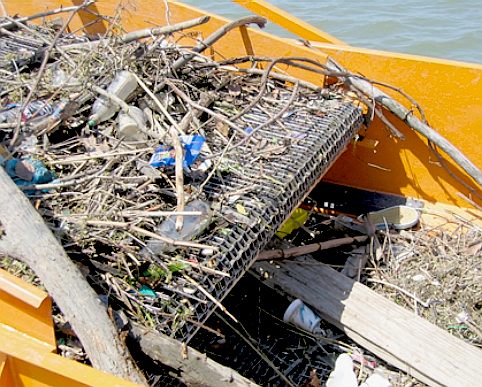

ALPHA
BOATS
Alpha Boats Unlimited is a worldwide manufacturer of Water Management Equipment, located in Central
New York.
They have experience in design and construction of boats for the care, treatment, conservation and maintenance of inland and coastal waterways. These include aquatic weed harvesters, marina cleaners, trash and debris skimmer boats, multi-purpose Hydro-Mate, transport and work barges, dredges, crane and work boats, as well as all support equipment.
TRASH
SKIMMERS or MARINA CLEANERS
Marina Cleaners are available in fresh water or salt water versions and feature an articulating vertical wing capture system that delivers debris to the front pick-up conveyor.
Large and small objects are easily retrievable and roll back is prevented with cross cleats.
The Marina Cleaners (MCs) are built with a low profile configuration for navigation under lower
bridges.
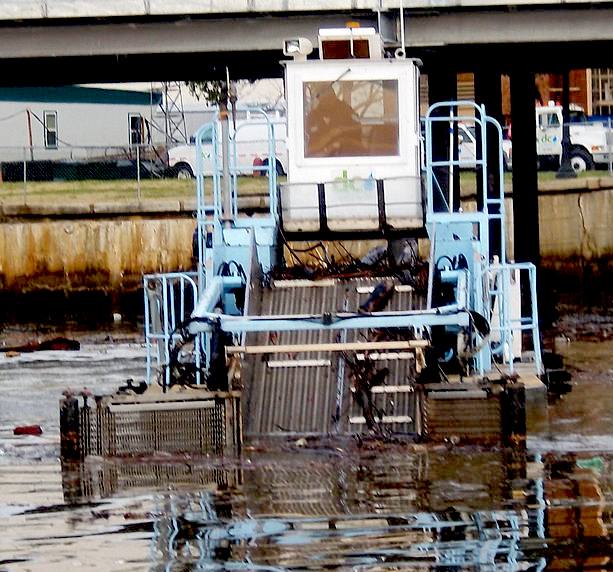
SPECIFICATIONS
All standard Marina Cleaners are featured and equipped with the following :
• A complete Hydraulic System for all skimming, load handling, and propulsion functions, with variable speed control at the operator's finger tips.
• A Air Cooled Diesel Hydraulic Power Unit, placed into a noise proofed, lockable engine room.
• Lockable Hydraulic Oil Tank, Filtration, Hydraulic Oil Cooler, Hydraulic Directional Valves.
• Stainless Steel Hydraulic Cylinder Rods.
• Operator's platform with a seat and console with engine controls monitoring system including warning lights, tachometer and hour meter, and hydraulic controls with pressure gauge.
• Conveyor Belt System made of heavy duty Stainless Steel supported by UHMD plastic tracks and interchangeable floors.
• Articulated Skimmer Wings
• Front Conveyor with adjustable depth setting and cleats mounted to belts.
• Storage Conveyor with load indexing and height adjustable discharge
• Twin Pontoon Steel Hull “hydro-dynamically” shaped, including multiple compartments, inner ribbing, tie and lift cleats, drains and vents, anti-skid deck, bottom skids, rub rails, gunnels.
• Two independent, bi-directional Hydraulic Propulsion Units with variable speed controls, bronze propellers, stainless steel shafts, drop arms, and hydraulic connections, as well as tunnel guards, and power tilt.
• Railings and Guards
• Stainless Steel Fasteners
• Marine Coating, following sandblast preparation, includes priming and finishing coats. Standard colors are Safety Orange and Blue
• Fire extinguishers, life jacket and life ring with 50 Ft. (15M) of rope
• Operators Manual, Parts Catalog and One Year Warranty
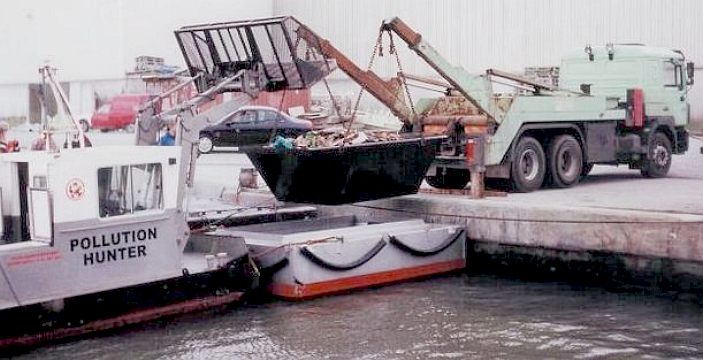
ALPHA
BOATS CONTACTS
Alpha Boats Unlimited
A Division of Barber Welding Inc.
2517 State Route 31
Weedsport, NY 13166 USA
Phone: 315/834-6645 FAX:
315/834-6045 Email:
info@alphaboats.com
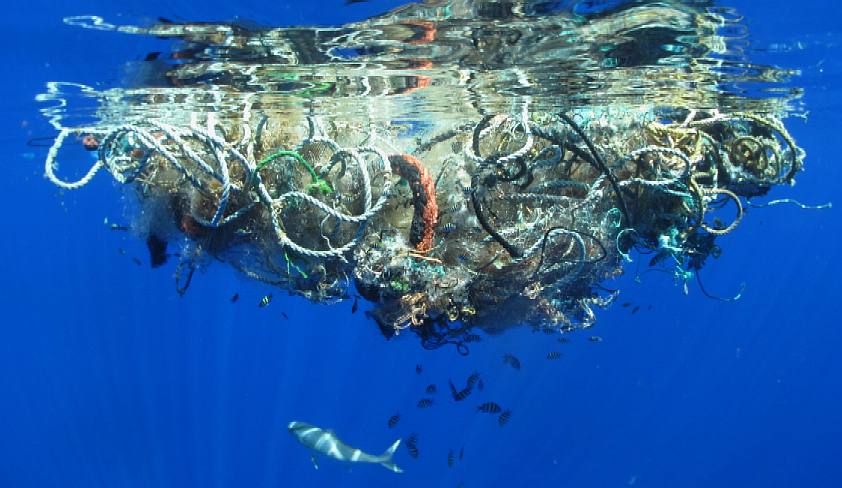
River
skimmers cannot (yet) deal with large rope and net entanglement. These are
the masses that claim the lives of so many turtles
and whales.
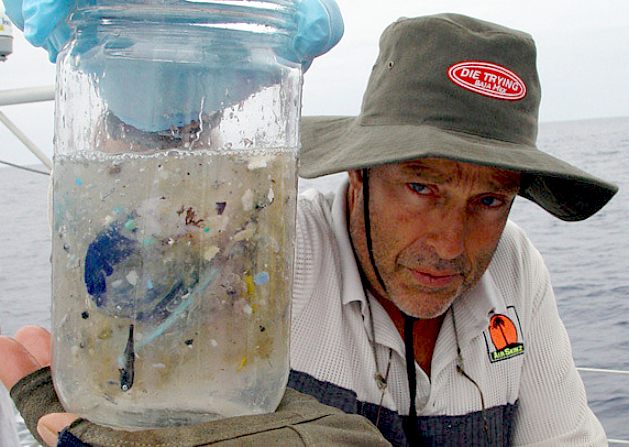
River
skimmers cannot deal with small bits of plastic as in the North Pacific
soup seen above. Another kind of filtration is needed that will not need
to be serviced every five minutes.
There are even more questions about the risks posed by those tiny bits of plastic. It's well-established that plastic can absorb certain toxic pollutants, like PCBs and DDT, and that those pollutants—if absorbed into an animal's fat tissues—can work their way up the food chain. But according to Miriam Goldstein, a doctoral student who served as principal investigator on a recent expedition to the Garbage Patch, we can't yet draw any firm conclusions about the plastic's effects on human health. For example, while we do know that some fish species are eating these specks of plastic, we don't know whether they're doing so in significant numbers. We also don't know whether ingesting bits of polluted plastic is enough to transfer those toxins from the plastic into the fish's fatty tissues. (For that matter, there's already plenty of PCBs and DDT in the water itself, so even if we could remove all the plastic from the ocean, we wouldn't necessarily be fixing the toxic fish problem.)
None of this is to say that plastic in the oceans shouldn't be an area of concern. But unless the flow of garbage is stanched at the source, cleanup can only ever be a
rearguard solution.
BBC NEWS
The
BBC points to 2 large skimmer boats (Thames Clearwater I & II, below) in the river
Thames, custom built by Damen Shipyards in the Netherlands and launched in September 2007. The catamarans (24 metres long and 8.20 metres wide) are outfitted with the screening technology currently employed in land-based facilities.
The screens, located near midships, are designed to pick up small debris which is then deposited into storage containers located on deck. Larger debris is captured at the bow in coarse mesh buckets, which also allows the smaller items to pass through and move towards the finer debris screens that are found midships.
In the US, skimmer boats have been in use since the early 1980s. United Marine International manufactures the TrashCat, which comes in 3 sizes (pictures below). About 100 of them are in use worldwide. They are capable of collecting up to 1200 cubic feet (34 cubic meters) of floating debris per load. US company Alpha Boats sells similar machines.
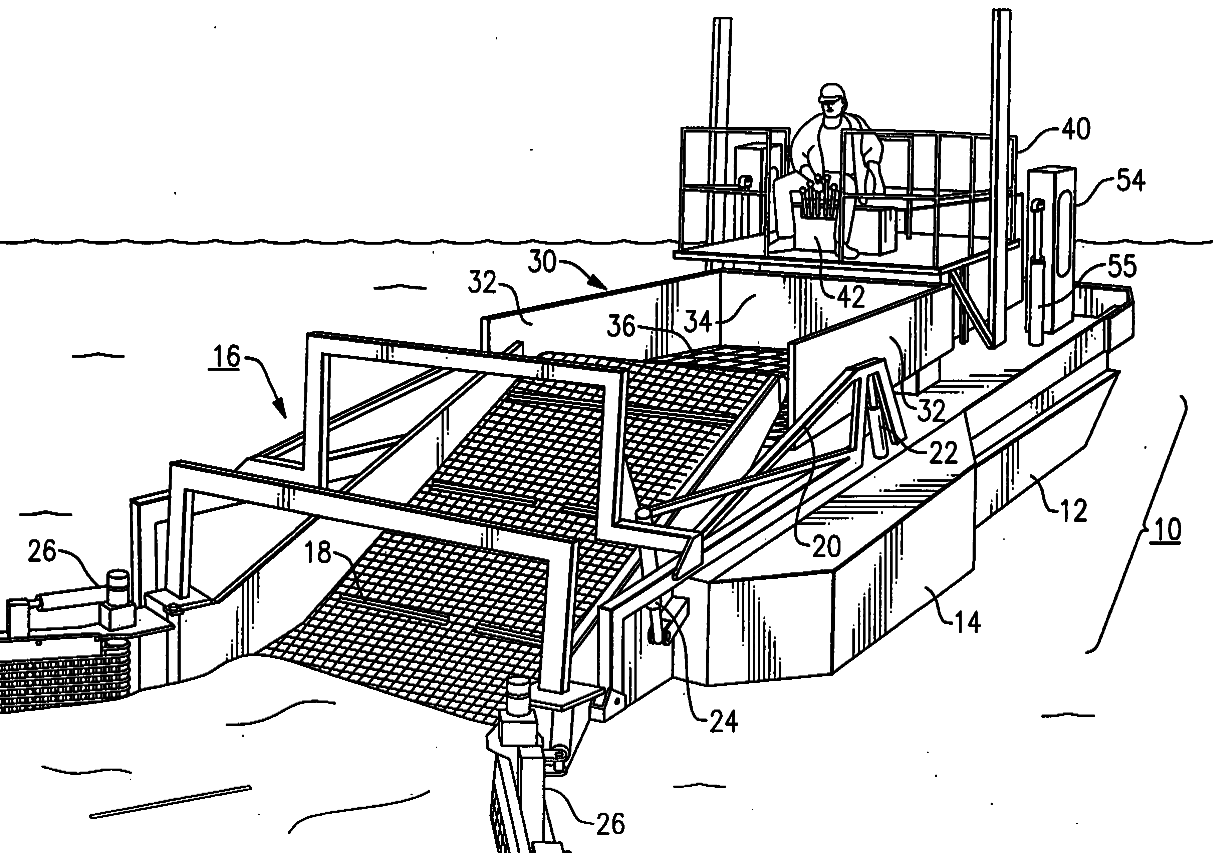
US
PATENT
DESCRIPTION 2004 - TRASH SKIMMER RIVER BOAT BACKGROUND OF THE INVENTION
This invention relates to skimmer boats, i.e., work boats for collecting and disposing of floating solid waste materials in harbors and waterways. The invention is more specifically directed to highly maneuverable vessels equipped with means for picking up floating debris, means for storing the debris on the vessel, and means for discharging the debris from the vessel to a storage area, which may be ashore or which may be another vessel such as a barge.
Many work boats and vessels have been proposed for collection of floating solid waste and other debris. These may typically be formed as a catamaran-type hull, i.e., a pair of pontoons or sponsons, or as a monohull, with paddle wheel or screw drive propulsion, and an operator station. In one typical trash skimmer design, one or more hydraulically powered open mesh conveyors are positioned between the pontoons of a catamaran-type twin-hull vessel. Twin over-the-rear propellers are used to propel and maneuver the vessel, and these can be tipped up for cleaning weeds and debris from the propeller blades. A main pickup conveyor extends off the front end, and extends into the water to catch the floatables, which it picks up and carries back to a main storage conveyor. When the storage conveyor is completely loaded, the boat is taken to a discharge position where the debris can be transferred to a truck or barge or other facility. A rear conveyor at the stern of the craft carries the debris from the storage conveyor up and back to drop it into the barge or on-shore storage facility. In some cases, a separate, on-shore conveyor can be used to pick up the trash discharged from the vessel.
In the vessels of this type, the debris or trash is picked up and loaded from the front, and is discharged from the rear or stern of the vessel. This means that there have to be three conveyor system, i.e., a pick-up or loading conveyor, a storage conveyor, and a discharge or unload conveyor. Second, because the region of the vessel on the centerline and sternward of the storage conveyor is occupied by the discharge conveyor, the motor, the cockpit or operator control position, and any other necessary equipment have to located to one side or the other, usually atop one of the pontoons. The control position may be located on a bridge standing over the storage area.
A number of skimmer boats of various designs for collection of floating solid debris have been proposed, for example, in U.S. Pat. No. 6,669,841 to Morin, U.S. Pat. No. 5,173,182 to Debellian, U.S. Pat. No. 5,028,325 to Hamilton, and U.S. Pat. No. 3,730,119 to Budris et al.
At present, there are no skimmer boats designed for loading and discharge from the same end using the same conveyor. Also, there are no work boats in which an auxiliary portion of the hull can be added for extra flotation for the forward conveyor, and can be removed to keep the vessel narrow enough to be trucked or trailered on a roadway. OBJECTS AND SUMMARY OF THE INVENTION
Accordingly, it is an object of the invention to provide an effective and efficient work boat for clean up of debris or trash from harbors, waterways, or other bodies of water, and which avoids the drawbacks of the prior art.
It is another object to provide a trash skimmer of improved design to facilitate loading of trash onto the vessel and discharge of trash from the vessel.
It is a further object to provide a trash skimmer vessel that is stable and easily maneuverable in the water, simple to operate for collection and discharge operations, and is easily trailerable for transportation by roadway between work sites.
According to one aspect of this invention, a trash collection skimmer boat is designed for collecting trash in a harbor, canal, lakeshore, or other body of water and later discharging the collected trash to a discharge station, i.e., truck or barge. The skimmer's flotation hull can favorably be of an open design, in which there are left and right (i.e., port and starboard) hull portions or pontoons, such that the hull has a bow or forward end and a stern or rear end. A storage conveyor positioned on the boat hull, favorably approximately amidships and along the center line. In a favorable embodiment, the storage conveyor has an open mesh web that travels over forward and aft rollers that define forward and aft ends of the storage conveyor. The storage conveyor is mounted to the hull on a slide or track arrangement that permits motion fore and aft for a limited distance relative to the hull. An actuator, i.e., a linear motor, moves the storage conveyor controllably in the fore and aft direction between its limits of travel.
A forward conveyor is mounted at the bow portion of the hull and is used for picking up trash or debris from the body of water and transferring the same to the storage conveyor. The forward conveyor is also used discharging the trash or material stored on the skimmer boat to a discharge station. A frame of the forward conveyor extends past the bow of the trash skimmer. The frame is mounted to the hull so that it can be tilted at a range of angles, up and down, and so that the proximal end of the forward conveyor can be positioned above or below the distal or forward end of the storage conveyor. The forward conveyor favorably has an open mesh web, and fore and aft rollers over which the web travels and defining distal and proximal ends of the forward conveyor.
The forward conveyor can be oriented by the operator, such that in a trash collection position the proximal end of the forward conveyor is positioned above the forward end of the storage conveyor, and in a trash discharge position the proximal end of the forward conveyor is positioned below the forward end of the storage conveyor. The storage conveyor is brought sternward so that there is clearance for the proximal end of the forward conveyor to be raised or lowered, and then is brought back forward so that the storage conveyor is in position to receive the trash and debris from the forward conveyor or to discharge the trash and debris onto it.
At the front or distal end of the forward conveyor there are preferably also a pair of supplemental conveyors. These are respectively carried on left and right jaw members or wings. These jaw members are articulated so that they can open and close laterally. This enables the front conveyor to pick up debris from a wide area at the front of the vessel. The jaws can be narrowed when loading from a narrow area, i.e., between slips in a harbor, for discharge, or for transport.
The engine for the vessel, which also powers the conveyors and the actuator, is mounted on the hull, favorably sternward of said storage conveyor and on the centerline. In one favorable embodiment, a stern hull portion is situated beneath the engine, such that the port and starboard pontoon members extend forward from the sides of the stern hull portion. This hull portion at the stern end provides plenty of buoyancy at the position of the engine. Favorably, the hydraulic pump and associated equipment are located adjacent the engine, and the hydraulic reservoir and valving are preferably located between the engine and a stern wall of the storage conveyor.
A pair of demountable auxiliary floats or sponsons are mounted outward of main hull on the port and starboard sides to provide additional floatation for the front conveyor when the boat is in the water. These auxiliary floats are removed from the hull when the boat is out of the water and needs to be transported by truck or trailer. Removal of these auxiliary floats permits the boat to be made as wide as possible. With the additional floatation removed, the rest of the boat hull is within legal width limits for road transport.
Propulsion and maneuvering are achieved with a pair of screw drives, each positioned at the stern of the vessel at port and starboard sides, with each screw drive having a respective hydraulic motor for powering it. Each screw drive is mounted on a respective elevator at the stern of the boat that permits vertical position of the drive to be adjusted to control the depth of the screw or propeller. Each elevator has an associated hydraulic cylinder or actuator. A control deck is supported on the hull and is elevated above the storage conveyor. The operator is positioned on the control deck and has access to hydraulic controls for the boat's functions.
The above and many other objects, features, and advantages of this invention will become apparent to persons skilled in the art from the ensuing description of a preferred embodiment, which should be considered in connection with the accompanying Drawing. CLAIMS
- TRASH SKIMMER RIVER BOAT 1. A trash collection skimmer boat for collecting trash in a body of water and later discharging the collected trash to a discharge station, the skimmer boat comprising:
a flotation hull that includes one or more floats, the hull having a bow or forward end and a stern or rear end; a storage conveyor on the hull and having forward and aft ends;
slide means on which the storage conveyor is mounted to the hull permitting the storage conveyor to move fore and aft for a limited distance relative to the hull;
actuator means for controllably moving said storage conveyor in the fore and aft direction over said limited distance; a forward conveyor for picking up trash from the body of water and for discharging the trash stored on the skimmer boat to said discharge station, including a frame extending past the bow of the trash skimmer, means mounting the frame to the hull, a web, and fore and aft rollers over which the web travels and defining distal and proximal ends of the forward conveyor; and
means for controllably orienting the forward conveyor such that in a trash collection position the proximal end of the forward conveyor is positioned above the forward end of the storage conveyor, and in a trash discharge position the proximal end of the forward conveyor is positioned below the forward end of the storage conveyor.
2. The trash collection skimmer boat of claim 1 comprising an engine supplying power to said conveyors and to said actuator, and wherein said engine is mounted on said hull sternward of said storage conveyor and on a centerline of said hull. 3. The trash collection skimmer boat of claim 1 wherein said hull comprises a main hull and also comprises a pair of demountable auxiliary floats mounted outward of said main hull to provide additional floatation when the boat is in the water but which can be removed from the hull to permit the boat to be
trailerized. 4. The trash collection skimmer boat of claim 2 wherein said hull comprises a stern hull portion beneath said engine and a pair of pontoon member that extend forward from the stern hull portion. 5. The trash collection skimmer boat of claim 2 comprising a hydraulic drive system including a hydraulic pump sternward of said storage conveyor and powered by said engine, and means connecting said pump with said actuator. 6. The trash collection skimmer boat of claim 5, comprising a pair of screw drives, each positioned at the stern of said hull and at right and left sides thereof, and each having a respective hydraulic motor powering the screw drive and coupled to said hydraulic pump. 7. The trash collection skimmer boat of claim 6, wherein each of said screw drives is mounted on a respective elevator at the stern of the boat to permit the vertical position of the drives to be adjusted so as to control the depth of the screw
drives. 8. The trash collection skimmer boat of claim 1, comprising a control deck on which an operator is positioned, the control deck being supported on said hull above the storage conveyor. 9. The trash collection skimmer boat of claim 8, wherein said control deck is centered on a centerline of said boat. 10. The trash collection skimmer boat of claim 1, wherein said storage conveyor includes a web and forward and rear rollers over which said web travels and defining forward and aft ends of said storage conveyor. 11. The trash collection skimmer boat of claim 10, wherein said storage conveyor can be controllably indexed in forward and reverse directions for incrementally moving said web during collection and during discharge. 12. The trash collection skimmer boat of claim 1, wherein said forward conveyor further includes a pair of supplemental conveyors disposed on left and right jaw members, respectively, situated at the distal end of said forward conveyor, with said jaw members being articulated to open and close laterally.
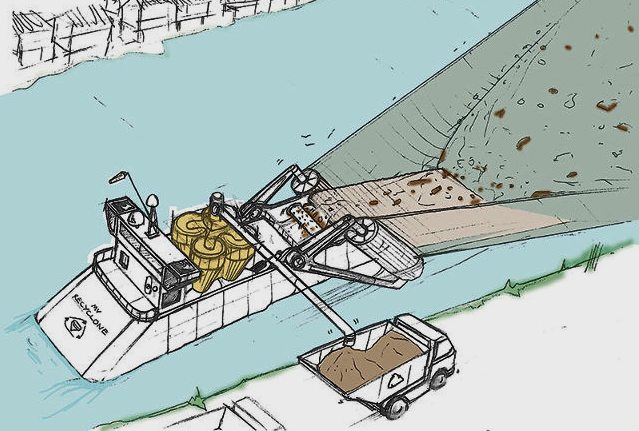
The
MV RECYCLONE - From James Dyson. We like it. But we're not sure that
cyclonic separation alone is sufficient for an ocean cleaner with lesser energy
available. It is though the experimental base. Not only has a system to work, but it must also be cost
effective. James is an inspirational example of a man who thinks
progressively of a better future. The drawing above was sketched for Time
magazine.
LINKS
Treehugger
solar water wheel could be solution plastic ocean debris
Google
trash skimmer patent US20060065586
http://www.google.com/patents/US20060065586
http://www.alphaboats.com/tsk_MC202Series.html
http://www.lowtechmagazine.com/2009/06/fighting-marine-debris-the-dustcarts-of-the-sea.html
http://www.lastnightsgarbage.com/?cat=56
http://news.bbc.co.uk/1/hi/england/london/6990610.stm
http://www.treehugger.com/clean-technology/solar-water-wheel-could-be-solution-plastic-ocean-debris.html
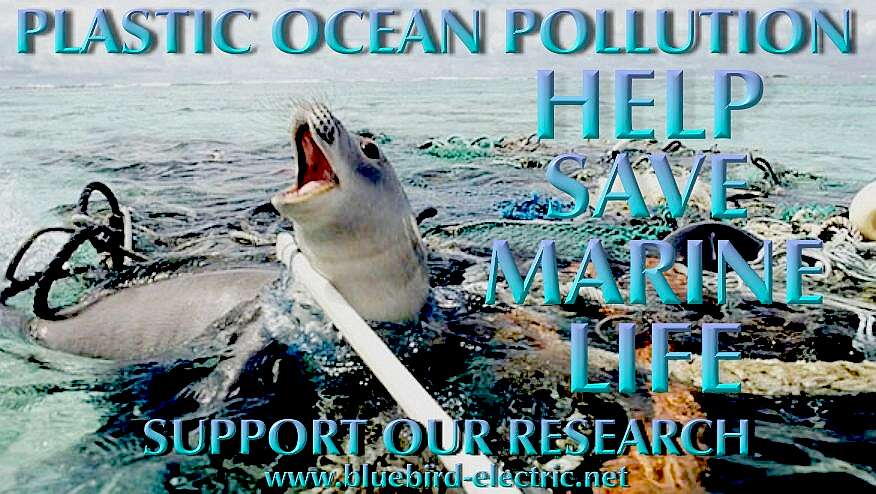
Our
love affair with plastic is choking the oceans. Once people know about it,
they want to stop it. But how? The next question is who?
Obviously, if any of the researchers involved so far had come up with a
solution, they would have
sorted it years ago. We are a practical think-tank fresh to the issue and
without a budget. We hope to be able to
collaborate with other marine organisations that are funded for this work,
or who have funds to investigate viable projects. You cannot donate to us
directly on this site, but we hope to identify partner sites shortly where
you can support a project much like that proposed herein, or better still,
our own practical
experiments with the SeaVax concept.
THE
WORLD'S DIRTIEST RIVERS:
ACIDIFICATION
- ADRIATIC
- ARCTIC
- ATLANTIC - BALTIC
- BAY BENGAL - BERING
- CARIBBEAN - CORAL - EAST
CHINA
ENGLISH CH
-
GOC - GULF
GUINEA - GULF
MEXICO
- INDIAN
-
IOC
-
IRC - MEDITERRANEAN -
NORTH SEA - PACIFIC
- PERSIAN GULF - SEA
JAPAN - STH
CHINA - PLASTIC
- PLANKTON - PLASTIC
OCEANS - SEA
LEVEL RISE - UNCLOS
- UNEP
- WOC
- WWF
AMAZON
- BURIGANGA - CITARUM - CONGO - CUYAHOGA
-
GANGES - IRTYSH
- JORDAN - LENA -
MANTANZA-RIACHUELO
MARILAO
- MEKONG - MISSISSIPPI - NIGER - NILE - PARANA - PASIG - SARNO - THAMES -
YANGTZE - YAMUNA - YELLOW
Youtube
Mr Trash
|



